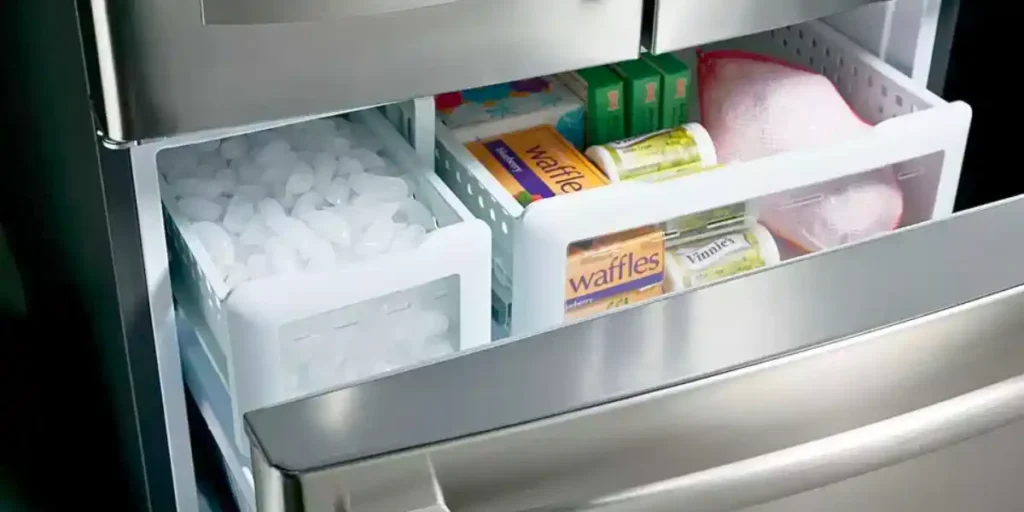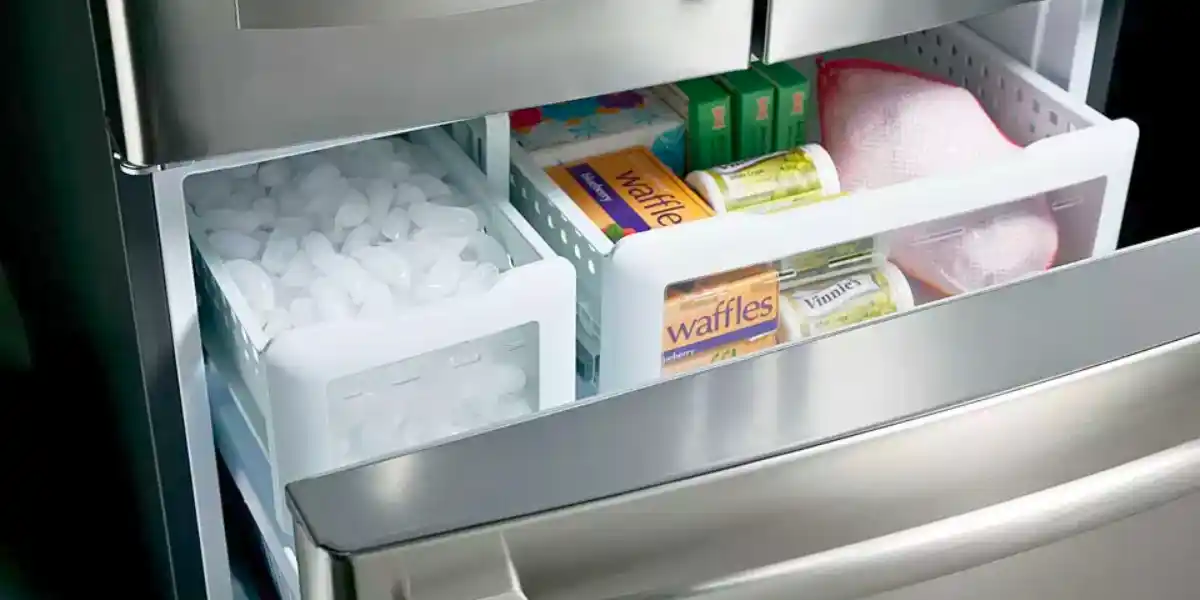
If your Kenmore bottom freezer ice maker is not working, it can be frustrating and inconvenient. There are several reasons why your ice maker may not be working, such as a frozen or clogged water line, a faulty water inlet valve, or a clogged water filter.
Let’s explore some of the most common reasons why your Kenmore bottom freezer ice maker may not be working and provide solutions to address them.
Quick Chart of Reasons, Symptoms, and Solution of Kenmore Bottom Freezer Ice Maker Malfunction
| Reason | Symptoms | Solutions |
| Freezer temperature issue | Ice maker won’t produce ice | Adjust the thermostat around -18°C or 0°F |
| Water supply problem | No ice production | Adjust the water line setting |
| Control arm malfunction | Stuck or broken control arm | Repair the control arm |
| Frozen lines | Slow ice production | Thaw the water line or clear any obstructions |
| Electrical issue | Damage or loose connections | Repair the electric connection |
| Clogged filter | Restriction in water flow | Replace the filter |
| Faulty water inlet valve | Insufficient ice production | Repair or replace the water inlet valve |
Common Reasons for Kenmore Bottom Freezer Ice Maker Not Working
Freezer Temperature Issues
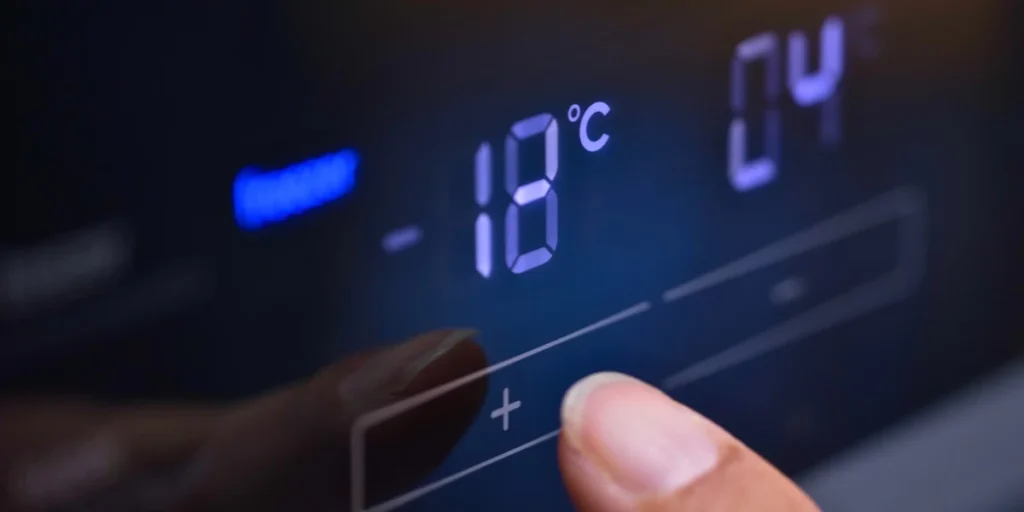
If your ice maker isn’t producing ice, it could be due to incorrect freezer temperatures. If the thermostat is set too low, it may prevent the ice maker from cycling and producing ice.
Adjust the thermostat to the recommended temperature setting for ice production. Ensure the freezer is set to the recommended temperature (usually around -18°C or 0°F).
Water Supply Problems
Issues with the water line, such as a kinked line or incorrect water line setting, can prevent the ice maker from working. No ice production could also indicate issues with the water supply.
Inspect the water line for any kinks or damage and ensure it is properly connected. Adjust the water line setting if necessary.
Control Arm or Sensor Malfunctions
If the control arm or sensor malfunctions, the ice maker may stop producing ice even when the bin is not full. Resetting the control arm or replacing a faulty sensor can resolve this issue.
Clogged or Frozen Lines
A frozen or clogged water line is a common reason for a Kenmore ice maker not working. Symptoms may include no ice production or slow ice production. Clogged or frozen water lines can prevent water from reaching the ice maker.
Electrical or Wiring Issues
Electrical or wiring issues can also cause the ice maker to stop working. Check the electrical connections and wiring for any damage or loose connections.
If necessary, consult a professional for repairs. Check for loose connections and ensure the ice maker is receiving power.
Pause Feature Enabled
The ice maker may not be working if the pause feature is enabled. This feature temporarily stops ice production. Check the control panel or user manual to disable the pause feature and resume ice production.
Clogged Filter
A clogged water filter can restrict water flow to the ice maker, resulting in no ice production or slow ice production. Replace the water filter if it is clogged or past its recommended lifespan.
Faulty Water Inlet Valve
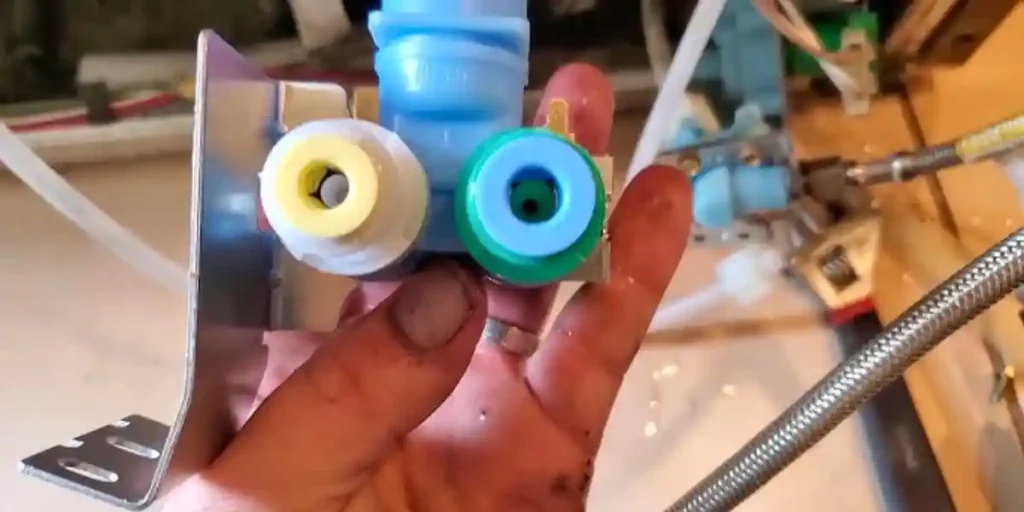
A faulty water inlet valve can prevent water from reaching the ice maker. This can lead to no ice production or insufficient ice production. Consider replacing the water inlet valve if it is malfunctioning.
Clogged Icemaker Mold Thermostat
A clogged icemaker mold thermostat can interfere with the ice-making process. Clean or replace the icemaker mold thermostat if it is clogged or faulty.
Failed Water Inlet Valve
A failed water inlet valve can prevent water from entering the ice maker, resulting in no ice production. Consider replacing the water inlet valve if it is not functioning properly.
Low Water Pressure
Insufficient water pressure can affect the ice maker’s performance. Check the water pressure and ensure it meets the manufacturer’s recommendations. If the water pressure is low, consult a plumber to address the issue.
Solutions for Common Reasons for Kenmore Bottom Freezer Ice Maker Not Working
Frozen or Clogged Water Line
To resolve this issue, examine the water lines at the rear of the refrigerator and ensure they are not frozen or clogged.
Thaw the water line or clear any obstructions. Use a hairdryer or warm water to thaw the water line. If there is a clog, use a pipe cleaner or a small brush to clear it.
Pause Feature Enabled
Check the control panel or user manual to disable the pause feature and resume ice production.
Water Line Malfunction
Check for kinks or blockages in the water line and ensure the water supply valve is fully open. Inspect the water line for any kinks or damage and ensure it is properly connected. Adjust the water line setting if necessary.
Thermostat Set Too Low
Adjust the thermostat to the recommended temperature setting for ice production.
Clogged Icemaker Mold Thermostat
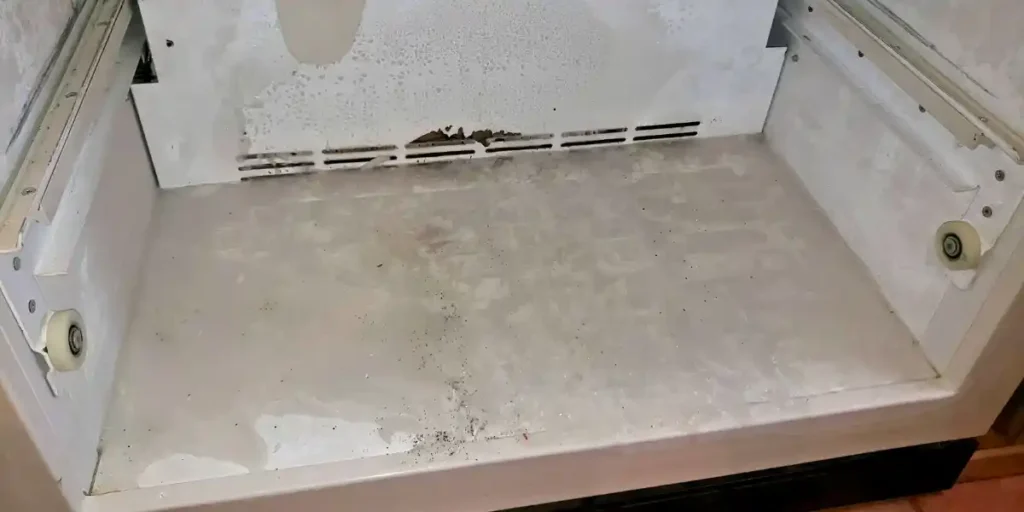
Clean or replace the icemaker mold thermostat if it is clogged or faulty.
Electrical or Wiring Issues
Check the electrical connections and wiring for any damage or loose connections. If necessary, consult a professional for repairs.
Failed Water Inlet Valve
Consider replacing the water inlet valve if it is not functioning properly.
Low Water Pressure
Check the water pressure and ensure it meets the manufacturer’s recommendations. If the water pressure is low, consult a plumber to address the issue.
Ice Maker Is Jammed
The ice maker is making weird noises. It’s stuck and won’t push ice out. To solve this, unplug the fridge. Safety first! Open the freezer. Look at the ice maker.
Check for ice cubes jammed inside. Use a soft spatula or plastic tool. Gently remove the jammed ice. Plug the fridge back in. Watch and listen to see if it works.
Water Supply Line Is Frozen
Find the water line on the back of the fridge. Feel the line. If it’s icy, it’s frozen. Use a hair dryer on a low setting. Gently warm the line. Wait for the ice inside to melt. Check the ice maker again. It should start making ice.
Faulty Water Inlet Valve
Turn off the fridge’s water supply. Find the water inlet valve. It’s on the back. Look for damage or mineral deposits. If broken, you might need a new valve. Get a grown-up to help replace it. Follow the fridge’s manual.
Broken Ice Maker Control Arm
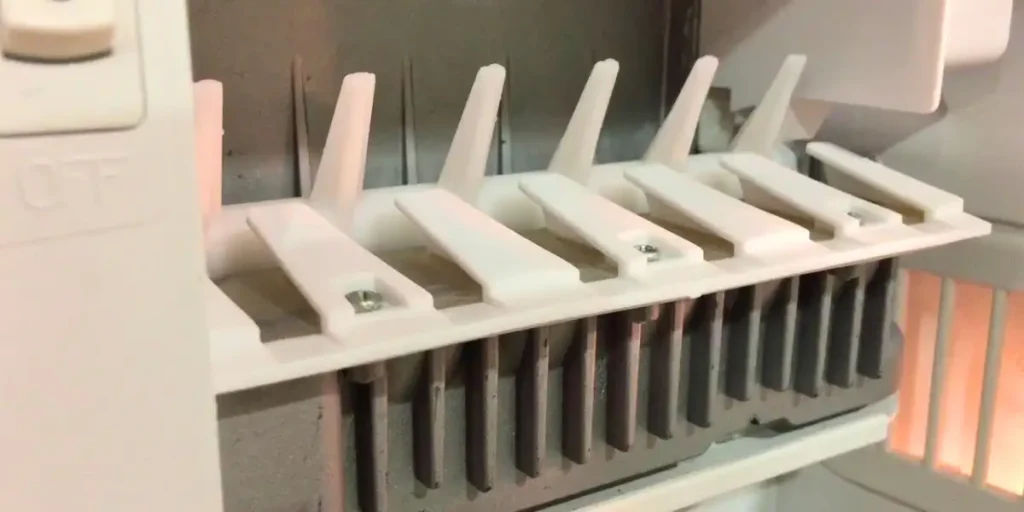
Check the control arm. It’s a metal or plastic bar. If it’s stuck, gently move it up and down. If broken, you might need a new arm. Get help from an adult to replace it.
Incorrect Freezer Temperature
Check the freezer temperature. It should be 0°F (-18°C). Adjust the thermostat if needed. Wait a few hours. Check the ice maker.
Filter Needs Replacing
Find the water filter. Check the fridge’s manual. If it’s old, replace it with a new one. Follow the instructions in the manual to change it.
Door Seal Is Damaged
Check the door seal. Look for cracks or tears. Clean it if it’s dirty. If damaged, ask an adult for help to replace it.
Troubleshooting Guide for Kenmore Bottom Freezer Ice Maker
If your Kenmore bottom freezer ice maker is not working, here are some troubleshooting steps you can take:
Reset the Ice Maker
Inspect for strange noises or stuck parts and remove any jammed ice cubes. It’s about making sure the ice can come out.
To fix it, start by turning the ice maker off, and then on again. Press and hold the test button for three seconds to initiate a manual harvest cycle.
Check the Water Supply
Ensure that the water supply to the refrigerator is turned on and that the water line is not frozen or clogged.
Inspect the Water Inlet Valve
Check the water inlet valve for any damage or malfunction. If necessary, replace the valve.
Clean the Water Filter
A clogged water filter can restrict water flow to the ice maker. Replace the water filter if it is clogged or past its recommended lifespan.
Adjust the Thermostat
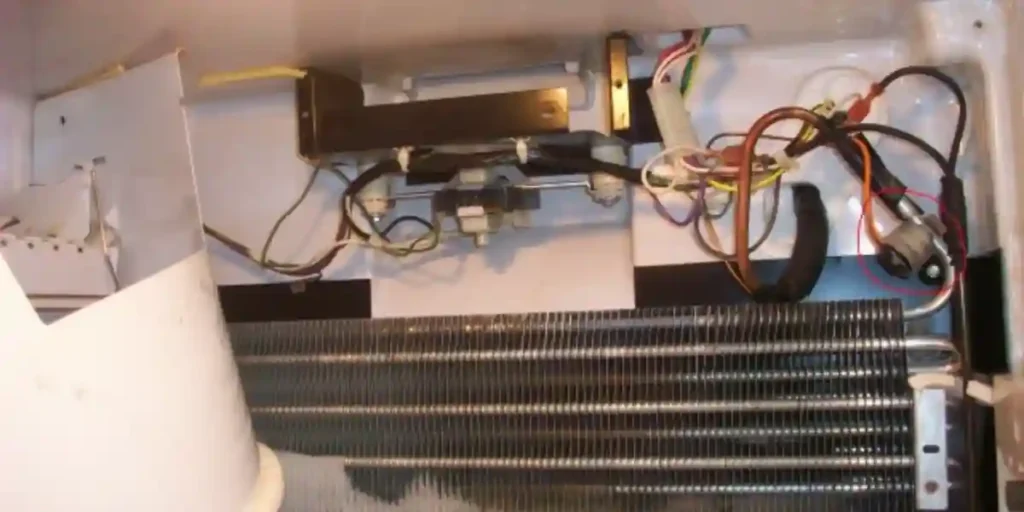
If the thermostat is set too low, it may prevent the ice maker from cycling and producing ice. Adjust the thermostat to the recommended temperature setting for ice production.
Check the Icemaker Mold Thermostat
A clogged icemaker mold thermostat can interfere with the ice-making process. Clean or replace the icemaker mold thermostat if it is clogged or faulty.
When to Seek Professional Help
If you’ve tried all of these steps and your ice maker still isn’t working, it may be time to seek professional help. Consider:
- Assessing the Severity of the Problem: If it’s a minor issue, you might be able to fix it yourself. However, more serious problems may require professional repair.
- Finding a Qualified Technician: Look for a technician who specializes in refrigerator repairs.
- Warranty and Repair Cost Considerations: Check if your appliance is still under warranty as this could cover some or all of the repair costs.
How Can I Enter Diagnostic Mode on My Kenmore 795 Refrigerator to Troubleshoot the Ice Maker Issue?
To troubleshoot any ice maker issue on your Kenmore 795 refrigerator, you can easily enter the diagnostic mode. By following a few steps, you can engage the kenmore refrigerator diagnostic mode explained. Once in this mode, you’ll have access to valuable information and specific tests that can help you pinpoint the problem.
Preventive Maintenance Tips for Kenmore Ice Maker
To keep your Kenmore Ice Maker running smoothly, consider these preventive maintenance tips:
- Regular Cleaning: Clean your ice maker regularly to prevent buildup and clogs.
- Proper Use of Controls and Settings: Use the correct settings as recommended in your user manual.
- Monitoring Water Quality: Poor water quality can affect ice production, so consider using a filter if necessary.
- Inspecting Seals and Connections: Regularly check seals and connections for leaks or damage.
- Avoiding Overstuffing the Freezer: Overstuffing can affect air circulation and temperature control.
FAQs
How often should I clean the ice maker in my Kenmore bottom freezer?
It’s recommended to clean your ice maker every six months.
What is the ideal temperature for the freezer to make ice?
The ideal temperature for making ice is around -18°C or 0°F.
Can I fix the ice maker myself, or should I call a technician?
Minor issues can often be fixed at home, but more complex problems may require a professional technician.
Where can I find replacement parts for my Kenmore ice maker?
Replacement parts can be found online or at appliance repair stores.
Are there any recalls or known issues with Kenmore ice makers?
Recalls or known issues would be listed on the manufacturer’s website or through consumer product safety websites.
Conclusion
Understanding how your Kenmore Bottom Freezer Ice Maker works can help you troubleshoot common issues and keep it running smoothly. Regular maintenance and proper use are key to ensuring its longevity.
If you’re unable to resolve an issue yourself, don’t hesitate to seek professional help. Enjoy the convenience of having ice at your fingertips with your Kenmore Bottom Freezer Ice Maker.

